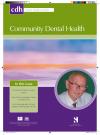Community Dental Health

- Cover Date:
- June 2013
- Print ISSN:
- 0265 539X
- Vol:
- 30
- Issue:
- 2
High acuity GIS comparison of dentist and doctor surgery locations in Auckland, New Zealand
doi:10.1922/CDH_2985Kruger05
Objectives: New Zealanders are one of the healthiest populations in the world, but significant inequalities in health and oral health remain. New Zealand suffers a possible shortage of medical and dental practitioners and an agreed mal-distribution of both. This study examines the distribution of dental and medical practices in New Zealand’s largest city Auckland, using modern Geographic Information System tools. The aim of the study is to determine if medical and dental practices are similarly distributed across the city. Design and methods: The address for each dental and medical practice in Auckland was obtained and mapped over the census population data. A total of 442 medical and 256 dental practices were geo-coded in the study area. These practices overlaid the Auckland region, with a total population of 0.8 million, and an adult population (>9 years old) of 0.69 million. Auckland city was deemed, for this study, to be a region included in a 15km radius circle from a central reference point that was the General Post Office (GPO). Results: The medical practice to total population ratio ranged from 1:1,500 for people 12½-15km from the GPO, to 1:1,200 for those within 2½km. Dental practice to population ratio ranged from 1:2,700 for people living 12½-15km from the GPO to 1:1,300 for those within 2½km. Medical practices were relatively evenly distributed, regardless of distance from the GPO, but the fairly dense distribution of dental practices in the city’s inner 2½km circle rapidly decreased in density as distance from the GPO increased. Conclusion: These results refute the hypothesis of this study in that there is a similar distribution of primary health practices (medical and dental) across the Auckland region.
Key words: GIS, health services, city planning, population density mapping, distribution
- Article Price
- £15.00
- Institution Article Price
- £
- Page Start
- 83
- Page End
- 87
- Authors
- E. Kruger, R. Whyman, M.Tennant
Articles from this issue
- Title
- Pg. Start
- Pg. End
- Barriers and facilitators that influence the delivery of prevention guidance in health service dental practice: A questionnaire study of practising dentists in southwest England
- 71
- 76
- Care home managers’ views of dental services for older people living in nursing and residential homes in inner city London
- 77
- 82
- Automated coaching to help parents increase their children’s brushing frequency: an exploratory trial
- 88
- 93
- Operationalisation of the construct of access to dental care: a position paper and proposed conceptual definitions
- 94
- 101
- Sociodemographic differences in oral health-related quality of life related to dental caries in Thai school children
- 112
- 118
- Short Communication - The cross cultural adaptation and validity of the Child-OIDP scale among school children in Karnataka, South India
- 124
- 126
- Short Communication - Defluoridation techniques implemented by the government of Karnataka, India – the current situation
- 127
- 128
